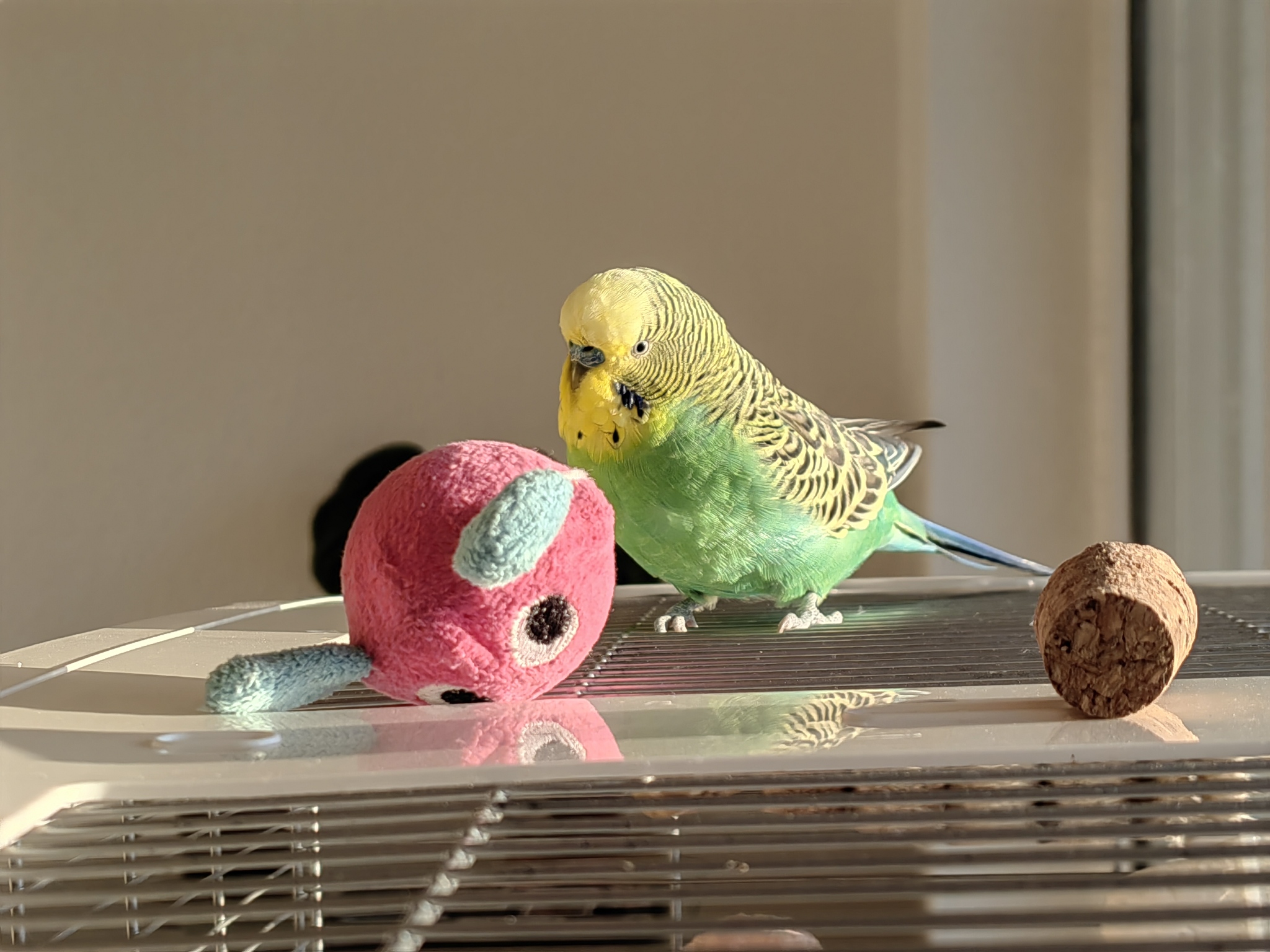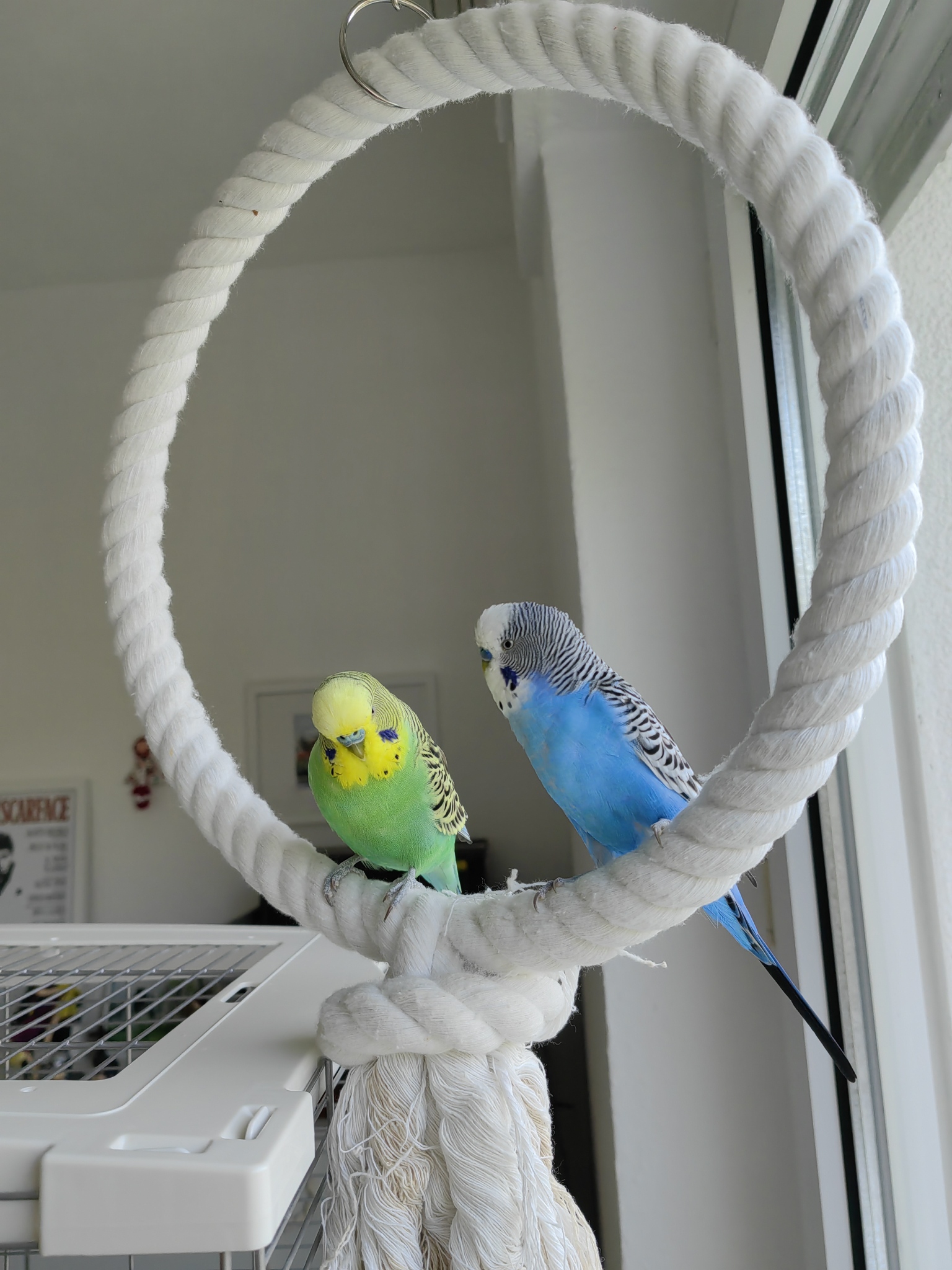The world’s third most popular pet is the Australian budgerigar. It’s kept in captivity more than any other pet and unfortunately, they can become sick and eventually die. There has been a major breakthrough that has shown that Vitamin D3 via sunlight eliminates many of the health problems budgies in captivity often face. For many years budgie owners have had disease problems. Many breeders have encountered disease outbreaks that almost destroyed their whole flock.
Vitamin D is a group of closely related compounds that possess antirachitic activity. They are obtained directly from the diet or from irradiation of the body. The two major natural sources (provitamins) are cholecalciferol (D3 in animals) and ergocalciferol (D2, predominantly in plants). Both D2 and D3 forms also can be ingested and further metabolized to 25-hydroxyvitamin D3 through hydroxylation first by the liver, and then again to 1,25-dihydroxyvitamin D3 in the kidneys. Cholecalciferol can be produced in the skin of most mammals from provitamin 7-dehydrocholesterol via activation of ultraviolet light in as little as 11-15 minutes daily. Vitamin D enhances intestinal absorption and mobilization of calcium and phosphorus through the hormone 1,25-dihydroxy vitamin D3.
The role of vitamin D
Vitamin D is important to budgies for several reasons.
- Calcium metabolism: Birds require vitamin D to properly absorb and utilize calcium from their diet. Calcium is crucial for the development and maintenance of strong bones and eggshells. Vitamin D helps regulate calcium levels in the bird's body, ensuring that calcium is absorbed efficiently and utilized effectively.
- Sunlight conversion: Birds have the ability to convert provitamin D, a compound found in their skin, to an active form of vitamin D3 when exposed to sunlight. This conversion occurs through a series of biochemical reactions. Vitamin D3 is essential for maintaining proper calcium levels, which is vital for skeletal health.
- Enhancing immune function: Vitamin D plays a crucial role in supporting the bird's immune system. It helps regulate and stimulate the immune response, enabling birds to fight off infections and diseases more effectively.
- Feather health: Vitamin D is necessary for the healthy growth and maintenance of feathers. Feathers are essential for flight, insulation, and display purposes. Adequate vitamin D levels contribute to the development of strong and vibrant feathers in birds.
- Reproduction: Vitamin D is involved in the reproductive processes of birds. It influences the production of reproductive hormones, such as gonadotropins, which play a role in the initiation and maintenance of the breeding cycle.
Signs of vitamin D deficiency in budgies
Budgies with vitamin D deficiency can experience various health problems and physiological abnormalities. Vitamin D synthesis can be affected by liver malfunction; intestinal disorders can reduce the absorption of the vitamin and kidney failure can prevent the synthesis of 1,25 (OH)2D3. Inadequate exposure to UVB radiation prevents the production of vitamin D in the skin. Glass windows block the penetration of UVB rays!!! The first signs of vitamin D deficiency include decreased egg production, thinning or absence of eggshells, and an increased incidence of embryonic death.
- Skeletal disorders: Vitamin D deficiency can lead to skeletal disorders such as rickets in young birds and osteomalacia in adult birds. These conditions result in weakened bones, poor bone mineralization, and skeletal deformities. Birds may develop bowed legs, soft beaks, or abnormal wing and leg bone growth.
- Reduced calcium absorption: Vitamin D is essential for the efficient absorption of calcium from the diet. Without sufficient vitamin D, birds may struggle to absorb an adequate amount of calcium, leading to low blood calcium levels. This can result in reduced bone density, brittle bones, and an increased risk of fractures.
- Weak muscles: Vitamin D deficiency can contribute to muscle weakness and poor muscle function in birds. This can manifest as difficulty flying, reduced stamina, or general weakness and lethargy. Muscles may not contract optimally, affecting the bird's overall mobility and coordination.
- Poor feather health: Feathers require proper nutrition, including adequate levels of vitamin D, for healthy growth and maintenance. Birds deficient in vitamin D may exhibit poor feather quality, including dull and brittle feathers, abnormal feather development, or feather loss. Feathers play a crucial role in insulation, flight, and display, so compromised feather health can affect a bird's overall well-being.
- Suppressed immune function: Vitamin D is involved in modulating the immune system. A deficiency can lead to impaired immune function and increased susceptibility to infections and diseases. Birds may have a weakened ability to fight off pathogens, leading to a higher risk of illness.
- Reproductive issues: Vitamin D deficiency can impact reproductive processes in birds. It may disrupt hormonal balance, affecting reproductive hormone production and regulation. This can result in reduced fertility, poor egg quality, or reproductive disorders.
- Chronic runny nose: Discharge from the nose.
Vitamin D deficiency is more common in budgies that have limited access to natural sunlight or a diet deficient in vitamin D. Indoor birds, those kept in cages or aviaries without exposure to direct sunlight, or birds on imbalanced diets lacking vitamin D sources are particularly at risk. Supplementing their diet with appropriate sources of vitamin D or providing exposure to safe levels of sunlight or full-spectrum UVB lighting can help prevent or correct vitamin D deficiency in birds. It's important to consult with a veterinarian knowledgeable about avian health to address and manage vitamin D deficiency in birds. Read here about the ideal budgie diet.
Signs of vitamin D toxicity in budgies
Vitamin D toxicity may arise from an excess of dietary vitamin D or a deficiency in other fat-soluble vitamins. Toxicity leads to widespread calcification of soft tissue. Toxic levels can be transferred maternally to the embryo, leading to abnormalities in chick development. Hypervitaminosis refers to an excessive intake of vitamins, including vitamin D, which can lead to toxicity. In birds, hypervitaminosis D can occur if they are exposed to excessively high levels of dietary or supplemental vitamin D.
- Increased thirst and urination: Birds with vitamin D toxicity may exhibit increased water consumption and increased frequency of urination. They may appear excessively thirsty or have wet droppings.
- Digestive disturbances: Birds may experience gastrointestinal disturbances such as diarrhea, vomiting, or regurgitation. Their droppings may become loose or watery.
- Loss of appetite: Birds with vitamin D toxicity may show a decreased interest in food and may refuse to eat or eat less than usual. This can result in weight loss and malnutrition.
- Weakness and lethargy: Affected birds may become weak and lethargic. They may appear inactive, spend more time resting, and show reduced overall activity levels.
- Increased egg laying or reproductive problems: In female birds, hypervitaminosis D can cause an increase in egg production or the laying of abnormal eggs. It may also lead to reproductive issues such as egg binding or decreased fertility.
- Increased thirst and urination: Birds with vitamin D toxicity may exhibit increased water consumption and increased frequency of urination. They may appear excessively thirsty or have wet droppings.
- Abnormal feather growth: Vitamin D toxicity can affect feather development, leading to abnormal feather growth, feather deformities, or feather loss.
- Kidney damage: Excessive levels of vitamin D can cause kidney damage in birds. This can result in kidney dysfunction, leading to further health problems and impaired excretion of waste products.
Vitamin D is converted in the liver to 25-hydroxycholecalciferol and then further hydroxylated to 1,25-dihydroxycholecalciferol in the kidney. Avian macrophages have the capacity to convert vitamin D to its active form 1,25-dihydroxycholecalciferol. It is 1,25 dihydroxycholecalciferol that enhances the intestinal absorption of calcium and phosphate. As a result of excessive calcium uptake, visceral calcinosis, nephrocalcinosis, visceral gout and urate nephrosis are considered frequent complications of vitamin D intoxication in birds. Symptoms of hypervitaminosis D include hypercalcemia, anorexia, nausea, polyuria, polydipsia, demineralization of bones, disorientation, painful joints and muscle weakness.211 In normal animals experimentally subjected to hypervitaminosis D, 25-hydroxycholecalciferol, and not 1,25-dihydroxy cholecalciferol increase in the serum.

Full spectrum lamps for budgies and other marketing scams.
The extensive new research done on humans is wonderful in its revelations and their possible relevance to budgies. Vitamin D3 does a lot more than build bones, it is a powerful anticancer agent and it regulates the immune system. Low Vitamin D3 levels in humans have been linked to many serious illnesses: various infectious diseases, cancers (such as breast and prostate), and autoimmune conditions. Identical twin studies showed that increased sun exposure as children can reduce the chance of developing multiple sclerosis by up to 57%. The same applies to autoimmune diabetes, Crohn’s Disease, and tuberculosis. New research has also confirmed that, in humans, vitamin D3 deficiency has been linked to infertility in women and poor quality sperm, and lower fertility in men. This is exactly what we have seen in budgies.
Vitamin D3 is not a vitamin at all since we make it ourselves (as do birds) and it acts more like a hormone: that is a messenger chemical that controls various functions. It controls well over 1,000 genes in the human body. In humans, ultraviolet B light (which is part of normal sunlight) acts on oil on your skin and turns it into Vitamin D3, which is then re-absorbed. In budgies oil is taken from the oil gland at the base of the tail during preening and is spread all over the feathers. This is turned into Vitamin D3 by sunlight and the birds consume it later on during further preening. This is essential for the budgies’ health.
I chose to write this article to share this with the world: Ultraviolet B light (UVB) does not travel through glass or clear plastic or fiberglass. Sunlight in general goes through, but not UVB light. So today’s modern aviaries and bird rooms are death traps for birds since little or no UVB light reaches the budgies themselves. Even “full spectrum” fluorescent lights lack UVB light. They produce the wrong sort of UV light, that is UVA. I advise against buying into these marketing scams. The light might even bother your birds and would do more damage than good.
The spectrum of optical radiation lies between 102 nm in the ultraviolet (UV) and 106 nm in the infrared (IR) spectrums. This wavelength range is subdivided into seven bands: UV-C, UV-B, UV-A, visible light, IR-A, IR-B and IR-C. The UV-B band in natural sunlight allows for the multistep conversion of 7-dehydrocholesterol into 1,25 dihydro cholecalciferol (vitamin D3), which is then reabsorbed by the skin or ingested during preening. Vitamin D3 is very important for calcium metabolism. If there is a lack of incoming sunlight, full-spectrum lamps can be used to induce internal vitamin D production in the skin. Also, environmental contamination can be reduced by UV light. The action spectrum for inactivation of microorganisms reaches its maximum at about 265 nm (DNA absorption). If artificial light is provided for breeding birds, the kind of radiation produced by the lamps is an important factor.
Natural sources of vitamin D
- Oranges
- Mango
- Cantaloupe
- Papayas
- Strawberries
Fruits should be offered in moderation because of excessive fructose. Placing your birds into the sun, cage half covered will do the trick.
